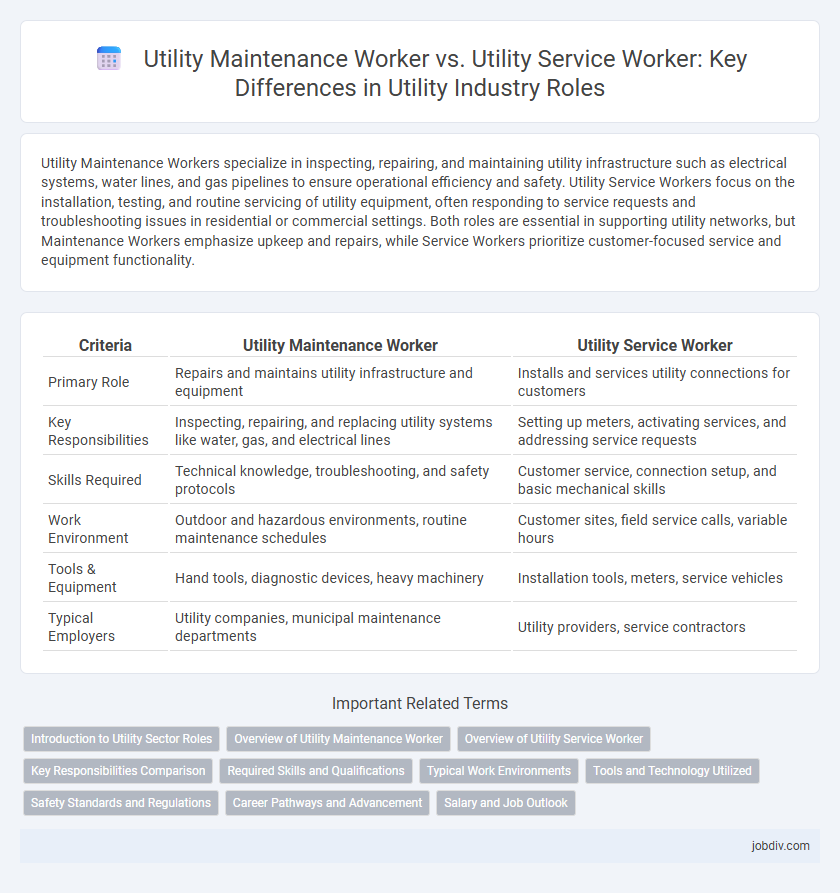Utility Maintenance Workers specialize in inspecting, repairing, and maintaining utility infrastructure such as electrical systems, water lines, and gas pipelines to ensure operational efficiency and safety. Utility Service Workers focus on the installation, testing, and routine servicing of utility equipment, often responding to service requests and troubleshooting issues in residential or commercial settings. Both roles are essential in supporting utility networks, but Maintenance Workers emphasize upkeep and repairs, while Service Workers prioritize customer-focused service and equipment functionality.
Table of Comparison
| Criteria | Utility Maintenance Worker | Utility Service Worker |
|---|---|---|
| Primary Role | Repairs and maintains utility infrastructure and equipment | Installs and services utility connections for customers |
| Key Responsibilities | Inspecting, repairing, and replacing utility systems like water, gas, and electrical lines | Setting up meters, activating services, and addressing service requests |
| Skills Required | Technical knowledge, troubleshooting, and safety protocols | Customer service, connection setup, and basic mechanical skills |
| Work Environment | Outdoor and hazardous environments, routine maintenance schedules | Customer sites, field service calls, variable hours |
| Tools & Equipment | Hand tools, diagnostic devices, heavy machinery | Installation tools, meters, service vehicles |
| Typical Employers | Utility companies, municipal maintenance departments | Utility providers, service contractors |
Introduction to Utility Sector Roles
Utility Maintenance Workers specialize in repairing and maintaining infrastructure such as power lines, water systems, and gas pipelines to ensure continuous service delivery. Utility Service Workers primarily focus on customer relations, meter reading, and addressing service issues to support operational efficiency. Both roles are essential for the reliable functioning of the utility sector, combining technical skills with customer service expertise.
Overview of Utility Maintenance Worker
Utility Maintenance Workers specialize in inspecting, repairing, and maintaining infrastructure related to water, gas, and electrical systems to ensure uninterrupted service and safety compliance. Their duties often involve troubleshooting equipment malfunctions, performing preventive maintenance, and responding to emergency repairs across utility networks. Proficiency in operating specialized tools, understanding utility blueprints, and adhering to regulatory standards is essential for effective utility maintenance work.
Overview of Utility Service Worker
Utility Service Workers specialize in operating and maintaining essential infrastructure such as water, gas, and electrical systems to ensure reliable public utility services. Their responsibilities include monitoring system performance, conducting repairs, and performing routine inspections to prevent service disruptions. These workers play a critical role in supporting community health and safety by ensuring continuous access to vital utilities.
Key Responsibilities Comparison
Utility Maintenance Workers primarily focus on the repair and upkeep of utility infrastructure such as water pipes, electrical lines, and sewage systems, ensuring system functionality and safety. Utility Service Workers handle customer service tasks, including meter readings, service installations, and addressing service interruptions, bridging operational support and client interaction. Both roles are essential for maintaining utility services, with Maintenance Workers emphasizing technical repairs and Service Workers concentrating on field operations and customer relations.
Required Skills and Qualifications
Utility Maintenance Workers require strong technical skills in electrical systems, plumbing, and equipment repair, along with the ability to interpret blueprints and use hand and power tools safely. Utility Service Workers prioritize skills in customer service, meter reading, data recording, and routine inspection to ensure timely and accurate utility service delivery. Both roles typically demand physical stamina, attention to detail, and a high school diploma or equivalent, with some positions requiring certification or vocational training specific to utilities.
Typical Work Environments
Utility Maintenance Workers typically operate in infrastructure settings such as power plants, water treatment facilities, and underground utility lines, often performing hands-on repairs and equipment upkeep. Utility Service Workers are usually found in customer-facing environments or field locations, addressing service installations, meter readings, and responding to outage notifications. Both roles require adaptability to various outdoor and indoor conditions, but Maintenance Workers tend to focus more on technical facilities, while Service Workers prioritize direct utility service delivery.
Tools and Technology Utilized
Utility Maintenance Workers primarily utilize hand tools, power tools, and diagnostic equipment such as cable locators and line testers to repair and maintain electrical, water, and gas systems. Utility Service Workers often operate heavy machinery, vacuum trucks, and GPS-based mapping technology to perform installations, service connections, and infrastructure inspections. Both roles demand proficiency in using safety gear and technology for efficient troubleshooting and system upkeep.
Safety Standards and Regulations
Utility Maintenance Workers and Utility Service Workers both adhere strictly to safety standards and regulations set by OSHA and relevant state agencies to prevent accidents and ensure compliance. Maintenance Workers focus on routine inspections, equipment repairs, and hazard identification, requiring specialized training in lockout/tagout procedures and confined space entry. Service Workers often operate in field environments performing emergency response and customer service tasks, necessitating rigorous use of personal protective equipment (PPE) and adherence to utility-specific safety protocols.
Career Pathways and Advancement
Utility Maintenance Workers typically focus on repairing and maintaining infrastructure such as water systems, electrical grids, and pipelines, building foundational technical skills essential for career advancement. Utility Service Workers often engage in customer service, system monitoring, and operational support, which can lead to supervisory roles or specialized technical positions. Career pathways for both include progression to senior technician roles, specialized equipment operators, or managerial positions, with advancement frequently supported by certifications and hands-on experience.
Salary and Job Outlook
Utility Maintenance Workers earn an average annual salary of approximately $50,000, with job growth projected at 5% over the next decade, reflecting steady demand for infrastructure upkeep. Utility Service Workers typically earn slightly less, around $45,000 per year, but have a higher job outlook growth rate of 7%, driven by increased utility service needs and technological advancements. Both roles are essential for maintaining and servicing public utilities, with salary variations influenced by specific responsibilities and regional demand.
Utility Maintenance Worker vs Utility Service Worker Infographic

 jobdiv.com
jobdiv.com